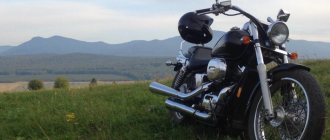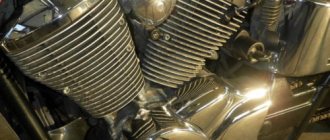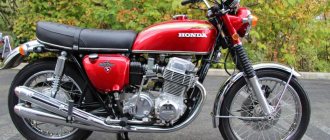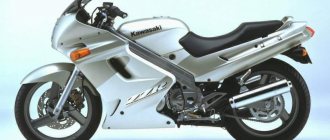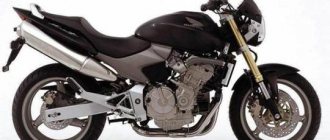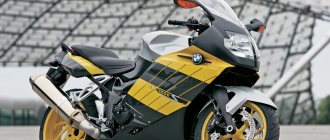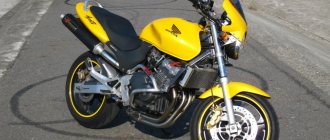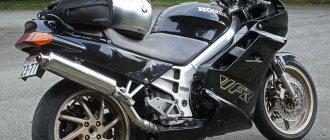The mid-sized cruiser Honda Shadow 1100 is a true road veteran. This model was first introduced to the general public in the mid-80s, and since then it has undergone many changes, becoming better from generation to generation. All over the world there are numerous clubs for fans of this model, the popularity of which has not faded to this day, despite the fact that the famous Japanese “Shadow” has not been produced for a long time, and there are many reasons for this.
Restyling
Two years later (in 1987) the bike was modified. This affected both the external appearance of the Honda Shadow 1100 and the technical component of the motorcycle. The model's wheelbase has grown. The mufflers, which were located on the sides, were moved to the right side of the motorcycle. At the same time, the power of the model was cut, now the engine produced only up to 67 horsepower. It should be noted that the engine's operating speeds have decreased, this has led to an increase in traction characteristics at the bottom and middle. The newfangled hydraulic clutch has given way to a standard cable version.
It was this modification in 1987 that marked the beginning of the road to legendary status that the Honda Shadow 1100 motorcycle eventually achieved. The first versions from 1985 and 1986 are extremely rare today and did not have good sales ratings in their time.
Modifications
There have been many varieties of the Honda Shadow 1100 over the many years of production. Let's name the main modifications of the motorcycle:
- Honda VT1100C Shadow (produced from 1987 to 1996). This is the basic entry-level version of the bike. Features of the model are its alloy wheels, dual exhaust on the right side, the tank of the model had a volume of 13 liters, the modification was equipped with a four-speed gearbox. A drum brake was installed at the rear.
- Honda VT1100C Spirit (produced from 1997 to 2007). This is to some extent the successor to the above-mentioned modification of the motorcycle. Visually the bike is very similar to its predecessor. The main difference is the shape of the exhaust, as well as the fuel tank and some other visual little things. Among the technical features and differences, it is worth highlighting the tank volume, which has grown to 15.8 liters, and the presence of a mechanical “five-speed” gearbox rather than a four-speed gearbox.
- Honda VT1100C2 ACE. (produced from 1995 to 1999). This, one might say, is the classic version of this motorcycle. The abbreviation ACE stands for American Classic Edition. The model is distinguished by stylized spoked wheel rims, elongated stylish fenders (front and rear), the wheel tires themselves are also different, they are wider, and a disc brake was installed at the rear. Some of the engine features include a crankshaft with one connecting rod rack (this is necessary to increase vibrations); the engine power was 53 horsepower.
- Honda VT1100T ACE Tourer (produced from 1998 to 2001). This is the touring version of the bike modification we just reviewed. The difference lies in the presence of special plastic cases, as well as a windshield. The wheels had alloy wheels and other rubber, the exhaust was implemented according to the “two-in-one” scheme.
- Honda Shadow VT 1100 Aero (produced from 1998 to 2002). This is similar to the aforementioned ACE version, but this variant has deeper wheel fenders, a larger headlight and a two-into-one exhaust.
- Honda VT1100C2 Saber (produced from 2000 to 2007). This is a similar modification to the ACE version. The characteristics of the Honda Shadow Saber 1100 were different, because this version had an engine from Spirit installed, and the difference was in the specially shaped rims.
All the best is for the Yankees!
Reinterpreting the famous statement of the classic of Marxism-Leninism, Japanese managers can rightfully claim: “The most important of all markets for us is the American one!” Vestimo: this glutton swallows the lion's share of large-capacity motorcycles produced all over the world, and it is these mastodons that bring the largest profits to concerns (“making a bigger hole is a simple matter... Well, okay, okay, I’m exaggerating this...). Therefore, the tastes and even the whims of the American consumer are satisfied immediately and unquestioningly. Knowing the Americans' passion for V-shaped engines, Honda engineers designed a family of V4 engines, which appeared in the fall of 1981 in the chassis of the classic Saber motorcycles and the choppered Magna. But here’s the problem: there were picky people in USA who, when they saw the new products, roared: “I want a V-Twin!” The confused Japanese wiped the fools' snot, but did not argue: just a year later they rolled out a family of Shadow cruisers (translated from English as “shadow”) with the coveted 2-cylinder engine. True, they did not immediately understand the mysterious American soul, and the new products turned out to be simply “high-tech” by the standards of that time: with liquid cooling (disguised by the abundant fins of the cylinders), 3-valve heads, 6-speed gearboxes, cast wheels and a cardan main transmission.
At first, the Japanese produced “twos” only in 500 and 750 cm3 formats, believing that lovers of large cubic capacity would be quite satisfied with the 4-cylinder 1100 cc Magna. No matter how it is! The Americans considered its 120-horsepower engine more suitable for sports bikes and demanded: “Give me something Harley-like!” The specialists from Honda again did not object. The VT1100C Shadow version was launched in 1985, and its assembly was organized at a plant in the USA: at that time, draconian duties were in effect on the import of motorcycles with engines with a displacement of more than 700 cm3 (adopted to save Harley-Davidson, which was losing its position in the market). Technically, the car retained the features of its younger sisters: liquid cooling, 3-valve cylinder heads, cardan transmission.
And only much later the time came for small cubic capacity V-Twins, which were no longer supplied to America (well, they don’t respect small things in the country!). In 1993, the 250 cc V25 Magna, intended only for the Japanese market, debuted (its copy, by the way, is produced by several Chinese and Taiwanese factories), and in 1998, the 125 cc version of the Shadow, which instantly became a bestseller on the European market. But technically, these machines are very different from motorcycles of medium and large capacity, and we will not touch on them in this review.
After 2003
Almost all of the modifications considered have become history over time. After 2003, the manufacturer produced only the basic modification VT1100C Spirit, as well as the VT1100C2 Saber. It must be said that both of these models reached 2007 without any major changes. These models were later discontinued. When this happened, she offered a successor in the form of the Honda VTX 1300. This was the end of the legendary era of the Honda Shadow of that design. Representatives of the company themselves said that they discontinued the model with great melancholy and sadness. But this is business, there is no time for sentimentality, it was necessary to impose a fight on competitors with a new, relevant model.
Fuel consumption
Officially indicated in the papers, the fuel consumption from the manufacturer for the Honda VT1100 Shadow is 5.2 liters for every 100 km of distance traveled. In practice, it comes out to at least one liter more, and the exact fuel consumption value depends on your driving style and manner and the quality of the fuel.
But as a rule, fuel consumption on such motorcycles is close to the declared one. After all, such devices are bought for measured travel in harmony with oneself, and not for crazy races from traffic lights to the squeal of rubber skidding on the asphalt.
002_MOTO_0810_020
On speed bumps, the motorcycle often catches on the crankcase, especially with the second number.
This is the price to pay for a low center of gravity. But on the asphalt of a major highway, the motorcycle stands as if on rails. On speed bumps, the motorcycle often catches on the crankcase, especially with the second number. This is the price to pay for a low center of gravity. But on the asphalt of a major highway, the motorcycle stands as if on rails.
Honda Shadow 1100: reviews
Let's start right away with the question of fuel. You shouldn’t skimp on it when the conversation turns to this motorcycle. Up to a certain point, the bike will absorb low-grade fuel without problems, but then big problems will occur with the fuel system, which will result in large financial expenses. It is for this reason that reviews recommend avoiding such troubles by refueling at decent gas stations.
Also, the owners of this motorcycle say that it loves to be maintained. If you service your bike in a timely manner with high-quality components and consumables, then there should not be any problems with the motorcycle.
007_MOTO_0810_020
As often happens, a beautiful and stylish speedometer on the tank is simply disgusting in functionality! The tiny kilometer scale and having to look straight into the tank rather than the road is very annoying. Yes, gentlemen, motorcycle manufacturers! It's time to equip choppers and cruisers with fuel level indicators in the tank! Even the ascetic “Sports” have a low fuel light, and I, like Mad Max, have to stop and turn on the gas tap. Rave!
Bravo for the light. An excellent headlight with excellent optics and beam focusing on the road. For aesthetes, we install bi-xenon - to be cooler than Easter eggs. Although there is a risk of losing in the saturation of the distant one. Continuing the series of pros and cons, I will mention that on Internet portals you can read about the tendency of this engine to burn spark plugs. I didn’t notice - proper work with the enricher at startup and the selection of the “correct” spark plugs in combination with the correct carburetor settings eliminate such problems. It’s a sin to be surprised that a motorcycle that is not endowed with any wind protection simply blows away at speeds over 130. Although after installing even a small windshield, the VTX is ready for long-range travel. If you are not going on a long trip alone, do not torment your friend - do not take her further than to a cafe, or put her on a train or plane. But the backpack, pulled into the place of the second number, usually does not complain. Large and VERY HOT pipes will burn not only the raincoat, but also the heels of the girlfriend in the passenger seat - keep this in mind. One good thing is that with the help of GOI paste and a felt circle on a drill, you can easily return the exhaust to its original state. Unfortunately, the same trick does not work with women's shoes.
Fit and comfort
We must pay tribute to the creators of the model. This bike is pleasant and comfortable to sit on. After long trips nothing hurts or becomes numb. Even tall and very heavy people can find a comfortable position. The long wheelbase of the bike does its job. It should be noted that the passenger seat is also very comfortable to sit here. It’s a pleasure to travel on such a motorcycle, including long distances.
A cruiser is supposed to be comfortable, but this model is as comfortable as the sofa in your living room. Add to all this the smoothness and softness of the ride, as well as the pleasant rumbling of the engine - and you get an ideal option for long-distance travel for your pleasure.
009_MOTO_0810_020
Having spent 12,000 km in the saddle per season, I have never once regretted buying a motorcycle “at the first call,” without hesitation and the pleasant agony of choice. This is a wonderful machine with an excellent set of user qualities. It's a pleasure to ride and ride on it. This is a large and stylish motorcycle for everyone who will appreciate its brutally elegant design. By the way, this is a very good price option for those who cannot afford the VTX1800, but want a beautiful, full-fledged, and most importantly, modern cruiser. Yes, the bike is not particularly suited to everyday driving through the city crowd, although for an evening promenade to a tavern it is actually an ideal option. For long trips, you need a windshield, a luggage backrest, roll bars (required!), panniers, or better yet, additional external footrests for the bars. With this kit you will completely ruin the characteristic appearance of the motorcycle, but no one bothers you to remove all this before evening rides around the city, right? The main thing is that the motorcycle has its own unique charm and character. Whether you become friends with him, as I easily managed to do, is up to you to decide!
Prices
The price for this motorcycle in decent good condition and without mileage in Russia starts at three and a half thousand dollars. If we talk about options in our market, then here you can find an option from one hundred and sixty thousand rubles.
And in our country you can find a good well-maintained bike, and abroad you can run into a “killed” version. As a rule, versions without mileage in Russia have the best technical condition, but there is always an exception to the rule. Before purchasing, carefully check the technical condition of the copy so that you do not later invest serious money in correcting problems caused by the previous owner.
As for the prices for spare parts, everything is approximately predictable. Not too cheap, but not prohibitively expensive either. Some kind of “golden mean”. But we must pay tribute to the original spare parts. They are very high quality and last a long time.
Not luxury =(
Due to the fact that the image set by Harley has acquired “cruising” capabilities, many such useful things are missing in such motorcycles. I don’t want to chase luxury tourers and their equipment, but a banal cigarette lighter and heated grips in the factory equipment for a “cruiser” would be a very reasonable solution. However, this is not only nitpicking, but I also have plans, and some of them have already been implemented - for example, the same cigarette lighter. Although it would certainly be nice to have another key position where some electrics would be turned on, the key can be removed. Or ABS.. Oh, dreams.
Actually, there are a minimum of basic equipment. Consider for yourself what I have:
- speedometer (in miles and kilometers)
- odometer (miles)
- odometer – “current trip” (in miles)
And indicators:
- high temperature
- little oil
- neutral (at the base of the steering wheel)
- turn signals (at the base of the steering wheel, not visible in the photo)
- high beam (at the base of the steering wheel, not visible in the photo)
And that is all. Although there is a lot of useful equipment for traveling, the same pressure (puncture) sensors in tires.
Thus, a cruiser, which is not a luxury tourer, is more of a motorcycle for “just riding” rather than a device for serious troubles. All this is very conditional, it would be stupid not to drive it somewhere far since, as you can see, it doesn’t have puncture sensors. People don't even drive like that. But this is the concept, and if you want to have this technique, you will have to accept it.
Honda Shadow 1100: technical specifications
It all depends on the specific modification. The characteristics of the Honda Shadow 1100 vary slightly depending on the version of the bike. But something can still be called something average. The weight of the motorcycle ranged from 245 kilos for the VT1100C version (years of production: 1985-1986) and up to 284 kilos (VT1100T version).
The VT1100C motorcycle (1987-1996 production) had the smallest tank; the volume was exactly thirteen liters. The largest fuel tank with a volume of almost sixteen liters had the versions of the last model years. The maximum speed of all models was 172 km/h, and acceleration to the first hundred was an average of six seconds.
The manufacturer chose a cardan as a drive; throughout the history of the model, a four-speed manual transmission and a five-speed manual transmission were offered in later versions. Cooling was always liquid, on all versions and modifications.
Motors were offered with two cylinders (four-stroke, V-shaped) from 53 “horses” to 78 horsepower in the very first motorcycle model series. The working volume of the power plant is 1099 cubic meters. The frame was made of high quality steel.
The front suspension was a telescopic fork with a travel of fifteen centimeters. The rear suspension was pendulum with a pair of shock absorbers (preload was adjustable), the suspension travel was ten centimeters. Thanks to the long wheelbase, the bike was very pleasant, smooth and soft to ride.
001_MOTO_0810_020
Honda VTX1300S: cruiser, 2005, 1312 cm³, 74 hp, 295 kg, 300,000 rubles, mileage 13,000 km
Honda VTX1300S: cruiser, 2005, 1312 cm³, 74 hp, 295 kg, 300,000 rub., mileage 13,000 km
By a strange coincidence, my friend’s “big brother”, the VTX1800C, appeared in my garage around the same time, so I consider it possible to refer to it from time to time. Externally, the VTX is distinctive and simply beautiful. A large V-twin, deep fenders a la Indian, a wide steering wheel, a dashboard on the tank, a massive clutch cover - everything is in the canons of the 21st century cruiser style. Although it is a Honda, it is assembled at a plant in western Ohio and is aimed at the US market. Do you like big American motorcycles? That's what I love! But not for brutality, but for stylish elegance, which provides him (and the rider, of course!) with constant attention from the fair sex (both the rider and not). Even with a minimum of tuning, it looks like a complete work of art. It is authentic in itself. It doesn’t need panniers or windshields, and at first you want to remove the passenger seat and leave it in the garage. But I want to upset the conservatives - there is much more plastic in it than in the 1800, so if anyone wants a “BIG IRON MOTHERBIKE”, it’s better to buy a “big brother” or a “Harley”.
In general, the device looks heavier than it actually is. The center of gravity is low, the seating position is suitable even for not very tall riders. The steering wheel is wide, wider than on the VTX1800, and therefore there is a risk of getting stuck in the city where another Gold Wing will fit through. In my opinion, a motorcycle is not particularly suitable for everyday trips around the metropolis. Review in the mirrors of the sluggish four. The seat is large but hard. There are platforms under your feet, so if you ride in anything more than airborne combat boots, I’m sure that the “kettle confuses the pedals” show for those around you is guaranteed! Although, after getting used to the “swing”, switching no longer causes such grinding of teeth as in the first days. We remember the Russian opposition, damn it!
However, let's move on to what is no less important for a cafe traveling further than the exterior - the hardware. The heart of the device is a V-shaped Honda. Today's, not yesterday's, production technologies and materials, modern design - all this gives the outwardly conservative power unit a set of excellent characteristics inherent in modern choppers. Steady idle, clear gearbox, trouble-free starting. One carburetor and liquid cooling - forget about the problems and don’t let the equipment carry you around! The dynamics at speeds up to 160 are even excessive, but then the engine has to work harder. In a convoy on the highway you won’t be ashamed of your motorcycle - the acceleration characteristics for this cubic capacity are excellent! The Vance&Hins direct-flow exhausts installed on my unit give an excellent velvety sound, but the quiet stock exhaust is preferable on long trips. After half a thousand kilometers at a time, I no longer quite understand exactly what is rumbling in my head - the rumble of the exhaust or the brains. Although in the city this is not at all annoying.
A long wheelbase imposes restrictions on the turning radius. The frame is quite rigid - by cruiser standards, of course. Large, chubby wheels help you navigate areas with cut asphalt as if on rails. But don’t relax in the rain - decent engine torque and a long wheelbase can add a lot of gray hairs not only in corners and during intense acceleration, but also on bitumen patches and sand. The pendants work. They just work. Remember that you are not on a cross-country bike - and nirvana on a normal road is guaranteed. And I simply feel sorry for driving “sticky” on broken asphalt. An unpleasant jamb of the chassis - at a speed of about 40-50 km/h, a progressive beating of the steering wheel begins - it’s better not to wipe off flies from the visor with one hand at such moments! Monitoring owner reviews showed that not only my copy suffers from tremors. But the drawback can hardly be classified as criminal - it’s easier to just get used to it.
There are brakes, as well as suspension. In my opinion, they are much more successful than on VTX's predecessor, the VT1100 Shadow, but, of course, they cannot be compared with the VTX1800 with its combined braking system and two discs on the front wheel. Eh, Honda, they were stingy... But take pity on yourself and the motorcycle - it’s not a sportbike after all! On it you are supposed to brake with your hand and foot at the same time, then everything is tip-top. Although lately I’ve been thinking more and more often about installing a reinforced brake hose on the front circuit.
Model competitors
This Japanese cruiser had two main competitors in its class. This includes the Japanese Yamaha XV 1100 Virago (Yamaha XVS 1100 Drag Star) and the Japanese Kawasaki VN1500 (Vulcan 88, VN-15). The fight was purely Japanese. But it was the Honda that became the main “samurai” in the class, although the struggle for leadership sometimes became serious, if you rely on the sales ratings of these motorcycles in different years of production. There were other competitors, but we named the main ones that made the manufacturer of this motorcycle nervous and worried about leadership in its class.
Bottom line
The Honda Shadow 1100 motorcycle is a worthy representative of its class. It can easily be classified as a legend, and random motorcycles do not fall into such a list. The appearance of the bike is very calm and classic (for its class), all characteristics are balanced and sufficient. Add here Japanese reliability and the relatively low cost of the model on the secondary market, and you get a very, very worthy option for cruiser lovers. On such a motorcycle you can travel around the entire planet, or you can just ride in your own city and beyond on weekends.
The motorcycle is loved and respected by bikers all over the world. This is a classic that is timeless. A simple hard worker in a stylish look. He will never let you down and will always deliver to your destination. This is a model of those years when motorcycles were alive, and not stuffed with various modern electronics and a variety of computer systems. This bike can be repaired in a garage environment on your lap. A model for those who appreciate the old school. A worthy copy for the garage of the owner who understands real motorcycles.
There is an opinion among motorcycle enthusiasts that one needs to grow into such a motorcycle from the point of view of motorcycle “philosophy”. There is some truth in this phrase, because a cruiser is almost never chosen as the first motorcycle, but very often experienced motorcyclists choose cruisers and never change class.
Reasons for popularity
These days, this bike is still very widely represented on the secondary market in Russia and other countries. The most common one on sale is the Honda Shadow 1100 Spirit, probably because there were so many of these motorcycles produced. Honda Shadow 1100 Saber is also often found, but old first-generation Shadows in a “living” state are difficult to find - age, alas, does not spare anyone. However, there is no point in chasing this modification specifically - the more recent Spirit, ACE and Saber easily outperform their ancestor in all respects - the Honda Shadow 1100 has very good technical characteristics even by modern standards.
The reliability of Honda motorcycles has already become a proverb, and absolutely deservedly so. Even 20-year-old Honda Shadow 1100s often feel great and look no less good, if, of course, they were in caring hands. But if the Honda did not spend the winter in a snowdrift under the window, and its previous owner did not reduce all maintenance to changing the engine oil, you won’t have to worry about its technical condition.
